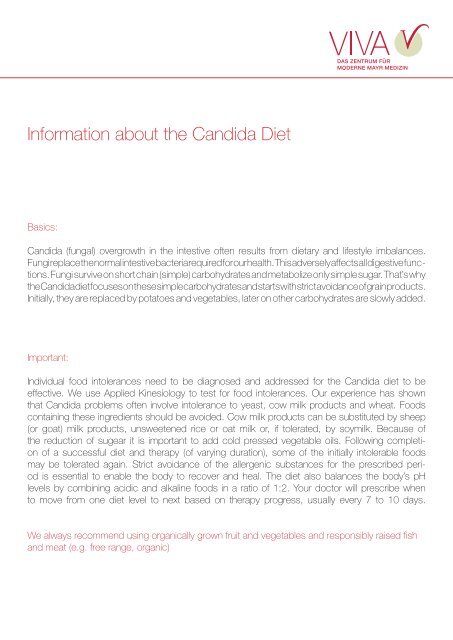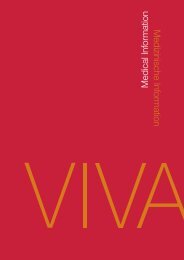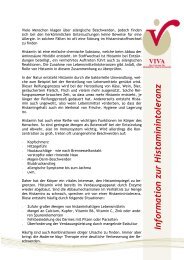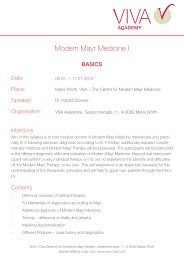Information about the Candida Diet
Information about the Candida Diet
Information about the Candida Diet
Create successful ePaper yourself
Turn your PDF publications into a flip-book with our unique Google optimized e-Paper software.
<strong>Information</strong> <strong>about</strong> <strong>the</strong> <strong>Candida</strong> <strong>Diet</strong><br />
Basics:<br />
<strong>Candida</strong> (fungal) overgrowth in <strong>the</strong> intestive often results from dietary and lifestyle imbalances.<br />
Fungi replace <strong>the</strong> normal intestive bacteria required for our health. This adversely affects all digestive functions.<br />
Fungi survive on short chain (simple) carbohydrates and metabolize only simple sugar. That’s why<br />
<strong>the</strong> <strong>Candida</strong> diet focuses on <strong>the</strong>se simple carbohydrates and starts with strict avoidance of grain products.<br />
Initially, <strong>the</strong>y are replaced by potatoes and vegetables, later on o<strong>the</strong>r carbohydrates are slowly added.<br />
Important:<br />
Individual food intolerances need to be diagnosed and addressed for <strong>the</strong> <strong>Candida</strong> diet to be<br />
effective. We use Applied Kinesiology to test for food intolerances. Our experience has shown<br />
that <strong>Candida</strong> problems often involve intolerance to yeast, cow milk products and wheat. Foods<br />
containing <strong>the</strong>se ingredients should be avoided. Cow milk products can be substituted by sheep<br />
(or goat) milk products, unsweetened rice or oat milk or, if tolerated, by soymilk. Because of<br />
<strong>the</strong> reduction of sugear it is important to add cold pressed vegetable oils. Following completion<br />
of a successful diet and <strong>the</strong>rapy (of varying duration), some of <strong>the</strong> initially intolerable foods<br />
may be tolerated again. Strict avoidance of <strong>the</strong> allergenic substances for <strong>the</strong> prescribed period<br />
is essential to enable <strong>the</strong> body to recover and heal. The diet also balances <strong>the</strong> body’s pH<br />
levels by combining acidic and alkaline foods in a ratio of 1:2. Your doctor will prescribe when<br />
to move from one diet level to next based on <strong>the</strong>rapy progress, usually every 7 to 10 days.<br />
We always recommend using organically grown fruit and vegetables and responsibly raised fish<br />
and meat (e.g. free range, organic)
Stage 1<br />
Monotony is an essential healing factor recommended foods:<br />
Vegetables (cooked):<br />
Potatoes, zucchini, eggplant, celery root (celeriac), fennel root, Swiss chard, pumpkin, carrot,<br />
spinach, red and golden beets, parsnips, tomato (small amounts), crimini mushrooms, avocado.<br />
Meat/Fish:<br />
Veal, poultry, lamb, egg, lean ocean and sweet water fish, Sheep and goat milk products,<br />
unsweetened oat or rice, milk, unsweetened soymilk, fresh herbs and spices, cold pressed oils<br />
(preferably, flax/linseed oil), almonds, soy.<br />
Stage 2<br />
grain rotation, one grain meal a day<br />
Rotation means a different grain is eaten once a day. Each type of grain is eaten only every 4th<br />
day. In addition to <strong>the</strong> foods from stage 1, <strong>the</strong> following foods are recommended:<br />
Grains:<br />
Millet, Quinoa, buckwheat, rice, yeast-free cracker bread, spelt, flod, corn.<br />
Vegetables (cooked):<br />
Garlic, leeks, bear’s garlic (allium ursinum), onions, asparagus, artichokes, all types of<br />
mushrooms such yellow boletus (edible boletus), chanterelles, morels, shitake and oyster<br />
mushrooms.<br />
Meat:<br />
Beef, venison, mild cheeses
Stage 3<br />
Rotation of grain meals, two grain meals a day, gradual introduction of raw foods as salads<br />
to accompany <strong>the</strong> midday meal. Foods that require more digestive capacity are introduced.<br />
In addition to <strong>the</strong> foods from stage 1 and 2, <strong>the</strong> following foods are recommended:<br />
Vegetables (cooked and raw):<br />
Cucumber, cabbage (Savoy, green and red cabbage, broccoli, cauliflower), legumes (beans, lentils<br />
etc.), bell pepper, radish.<br />
Grains:<br />
Spelt, oats, rye, barley (as cracker bread, noodles, etc.) Nuts<br />
Unsuitable Foods that can Promote <strong>Candida</strong> Growth:<br />
Sugar<br />
Grains<br />
Fruits<br />
Cold, Cuts and<br />
Sausages<br />
Alcohol<br />
Yeast<br />
White and brown sugar, raw cane sugar, honey, dextrose,<br />
maple syrup, pear or apple concentrate, fruit concentrates<br />
White flour and white flour products such as bread,<br />
pastries, cookies, cake etc. (note individual intolerances)<br />
Especially sweet fruit in all forms, also dried and<br />
preserved, fruit juice, and fruit concentrates<br />
Made from pork (also note thickeners and sweeteners<br />
used in many cold cuts and sausages)<br />
Of any kind<br />
Baker’s yeast, brewer’s yeast and everything made<br />
from it (based in individual testing)<br />
Processed foods, fast foods, canned foods and soft drinks.<br />
Fur<strong>the</strong>r Reading:<br />
Stossier H. Treating Allergies with <strong>the</strong> F. X. Mayr Cure, Hang Verlag
Your individual <strong>Candida</strong> Therapy:<br />
first week:<br />
Recommendations over <strong>the</strong> period:<br />
second week:<br />
third week:<br />
fourth week:









